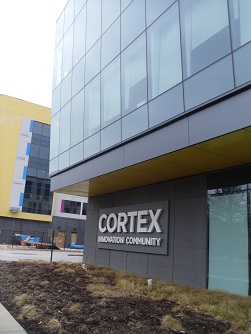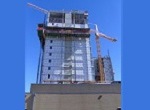Benefits and Components of an
Innovation District
Last Updated: June 20, 2024
Would your community be ripe for clustering start-ups and technology firms in one area to encourage interaction and sharing of ideas and resources? If so, you need to learn about innovation centers.
Barcelona is thought to have invented the notion of an innovation district around 20 years ago. Since then, another hundred medium-sized and large cities worldwide have created such a district or at least started down that path. I do not write this page suggesting that everyone try to copy the concept, and indeed there are dangers for some cities in doing so. I describe our criteria in the last heading on the page. Yet the term is becoming recognized in wider circles, and I am sure that some additional cities would reap economic development benefits from such an approach. So I march ahead in the style of trying to interpret current community development trends for community folks and activists.

This article was first conceived before the coronavirus pandemic started, so the very real and important trend toward "work from anywhere" is altering the dynamics of innovation districts in some fundamental ways. But as public health concerns ease or become manageable, the human need for social interaction is resurgent to some extent. This means I think this concept remains highly relevant in economic development and community development circles.
There is no one-size-fits-all definition of an innovation district, but most recognized innovation districts, which might also be called innovation zones, hubs, or precincts, consist of at least some of the following components:
- Well-established existing businesses, including those that provide business-to-business goods and services, providing their internal culture emphasizes and permits innovation and encourages mutual support among firms
- Start-up companies, within an incubator framework or simply as free-standing businesses
- Businesses that are ripe for scaling up or for participating in what is sometimes called a business accelerator (an organized framework for helping businesses that are beyond start-up but still in need of a growth spurt)
- Public open space, which might consist of green space, small parks, greenways, or multiple plazas of various sizes
- A system of walkways and very narrow streets that encourages the repetitive social interaction necessary to build the relationships that support exponential business growth
- Common meeting spaces, which sometimes may be rented to the general public as well to generate some revenue
- University or private sector research facilities and branches of companies
- Existing or new co-working facilities
- Advanced technological features not easily mimicked in other business districts, including forward-looking smart city disruptions
- Environments friendly to the complete array of transportation options, including conventional car parking, ride hailing, autonomous vehicle sharing, delivery robot accommodations, designated drone zones, designated e-scooter and e-bike rental or usage spaces, and proximity to transit and transit routes convenient to downtowns and other business centers in the city.
- High-energy amenities such as gyms, restaurants, and coffee shops or other "third places" for informal gathering, with all amenities oozing forward-looking trends in food, fitness, recreation, and more.
Other possible anchors include advanced manufacturing facilities and large governmental agencies, provided they are excited about working in an open innovation environment. (Open innovation simply means that a company or agency seeks and welcomes innovation ideas from outside its own structure.)
Sometimes the innovation district is based on a particular industry cluster of similar and related firms in which the city has strength. Because large medical centers are prominent features of a number of these, biomedical innovation is a common example. At other times the specialization will be based on a cluster previously identified when economic development agencies performed a cluster analysis or simply an economic base study.
But we think most cities that have adopted the innovation district concept have opted for a wider array of businesses than that implied by an economic cluster. This is true because software, apps, artificial intelligence, robotics, or other cross-cutting technology types may have become more important in determining whether businesses are mutually supportive than a strict interpretation of what has been considered an industry cluster in the recent past.
Oh, and innovation districts often incorporate businesses in creative industries, such as graphic arts, culinary arts, marketing, and all aspects of design, certainly including product design and even architecture. Especially if you have a design or architectural school nearby, consider whether a design emphasis could be part of your mix.
You also may want to incorporate an existing or new maker space; the tinkering mentality may be highly correlated with inventiveness in business, and it may give older teens and college students a path toward meeting and engaging with entrepreneurs.
Spaces for goofing off also can be important to generating new ideas. If a worker is stuck on a knowledge problem, a quick game of pool or ping-pong might be just the right mental break, and the best districts will recognize the need for human physical and mental refreshment.
In all cases, an innovation district occurs within a physical space, comprising at least a couple hundred acres, with defined boundaries. Density of economic, physical, and social activity within a relatively small periphery is essential to the concept. The intensity of interaction necessary to drive innovation on a consistent basis occurs in cities, not in suburbs and not in rural areas.
Often these centers are located either in the historic downtown or within a mile or two of it along a major arterial or transit route. Location often is dictated by the pre-existing locations of universities, hospitals, and large firms that will serve as anchor institutions for the fledgling district. Sometimes it follows a waterfront or a corridor, but we recommend a compact district rather than a linear shape if possible. Physical remoteness can equal social remoteness in the business world as well as the personal world, and innovation thrives on face to face interaction.
Sometimes the innovation district has been created through a conscious act on the part of economic and political entities, often in collaboration with important higher education or hospital entities, which you may hear referred to as "eds and meds" in English. At least as often, the district begins to grow somewhat accidentally due to the proximity of a few key businesses and institutions. In either case, as soon as the district idea begins to gain traction, it is important to assemble the land and existing buildings that will be needed for success. Don't allow speculation to drive up the cost of real estate.
Some of the most successful innovation districts have been organized as nonprofit corporations and then received major donations of millions of start-up dollars from stakeholders including universities, major hospitals, local or regional governments, and research-oriented institutions such as botanical gardens or oceanographic institutes.
Physical Characteristics Leading to Successful Innovation Zones
Since we have insisted that an innovation district requires a physical space, let's look at the types of buildings, transportation, and recreational components of the area needed for people to interact successfully. Since many of the workers in innovation districts tend to be young, well-educated, and by definition interested in urban environments, the wisdom thus far seems to be that you need high quality public spaces, walkable environments, a hip vibe, and transit-adjacent facilities.
The importance of talent attraction and retention cannot be overestimated. People with rare skills and knowledge are in demand globally, and increasingly they are willing to relocate to another country if necessary to realize their dreams. While maybe half of the employees of your innovation district at full build-out might be your own under-employed residents lacking in advanced degrees, you really do have to worry about attracting and retaining the other half, who are highly mobile. So if your irreplaceable workforce wants to live in a dense, walkable, bikeable urban environment, give it to them.
State-of-the-art internet access of course will be essential as well. You may need a new wi-fi district and ubiquitous small cell technology to keep employees and their gadgets, appliances, and shared autonomous vehicles in touch with one another.
If cities have the option, they should draw boundaries for innovation districts that take advantage of proximity to attractive residential neighborhoods with mixed ages and sizes of housing. If housing is in short supply in your city, certainly it is viable to include housing in mixed-use buildings right within the innovation district, especially since you want to avoid charges of gentrification if you can. (That is enough of a challenge given that half of your workforce in the district is likely to be of the pay grade and disposition often charged with fomenting gentrification.)
However, if you have a surplus of housing within a reasonable commuting distance, we definitely advise concentrating on business and amenities within the zone and leaving housing to the market.
Another important consideration is the relationship of your hub to the wider community. Universities often orient themselves inward toward a quadrangle courtyard, but you need to talk them into outward-facing buildings on the boundary streets to signal to the community that they are welcome. Of course these buildings need plenty of back doors too!
When your district includes older buildings, such as perhaps abandoned factories, consider the quirkiness an asset rather than a problem. In fact, if you need an abundant quantity of new construction to have enough square footage for the businesses you want to attract and grow, design some personality into buildings of various sizes and shapes, and cultivate and even require architectural detail and variation.
We repeat that you shouldn't skimp on transit. You simply must have good access to the airport and to downtown and financial and government centers, and your target employees don't want to be car-dependent. Some bicycle sharing and quick micromobility transportation methods, including electric scooters and such, also are in order. Make sure you have designated curbs for ride-hailing pick-ups. Plan the locations for food trucks, which are a staple right now for innovation districts.
Hyper-Focused Management Is Essential
Our observation after visiting several of these districts, and "wannabe" districts, is that unified management of the physical spaces and shared facilities is a prerequisite to success. This may or may not include planning control of the zoning, site plans, facades, and architecture of proposed buildings; if the city government will not relinquish and delegate that control to the district's central management, the coordination between the two must be exquisite.
We recommend that the city set up a new zoning district for an innovation center, with land uses and building masses desirable in your particular situation outlined in the ordinance. Special site plan review processes may be in order. Flexibility may be required; for example, a particular business may require a large footprint building with its spaces on a single floor, while other parts of the district need to accommodate smaller buildings to bring about the desired synergy across firms and organizations.
We suggest that the city delegate considerable authority to the management of the district, after careful delineation in the zoning or other land use regulation of the public purposes to be achieved through that delegation.
Alternatively, if the city is unwilling to add a zoning district tailor-made for the particular center you envision, the city could impose overlay zoning on a portion of an already existing zoning district. Overlay zoning simply means a mapping and listing of additional or different requirements for parts of the regulations attached to a particular zoning district. For example, your overlay might reduce parking requirements, alter building setback requirements, change height limits, or outlaw surface parking lots.
The manager will recruit businesses (including crucial relocations from other cities or from other locations in the same city), help create and maintain a culture of creativity and collaboration, create and program events and venues for mingling, plan and evaluate common facilities, and lobby the city government, utilities, and other agencies, including the transit agency if separate, to meet the infrastructure and service needs of the innovation district.
An important role also is determining whether to focus on one particular part of the geography, to designate and develop certain nodes before others, and to figure out how to make the innovation district coherent and yet porous to the community at each stage of its development.
Dispersed management, or management by city government, simply will not get the job done in most cases.
Managers who will not say no to inappropriate activities and tenants also will not foster success. Find a respected and experienced economic development professional; this is not the occasion for hiring some bright young person with a couple of years of post-college experience. This job requires extreme savvy, tenacity, ability to commit to the project for a number of years (we would suggest looking for a 7 to 10 year informal commitment), an understanding of how to organize physical space, and a personality, mind, and disposition that will add to the culture of innovation. Current and responsive contacts within the world of venture capital are a must, since of course financing is usually the premier issue for start-ups and scale-up companies. A history of inventing programming and special events will be a plus.
The manager must be sensitive to the needs of entities of all sizes and levels of maturity. If there are university centers or departments involved, either a higher education faculty or administrative background, or a history of working explicitly with higher education and economic development issues, will be required. For science and technology based centers, the manager will need the capacity to understand research needs and to spot facility opportunities such as efficiency-promoting shared labs.
You also will need skill in figuring out how to finance this innovation district. Cities have used many variations on typical economic development incentives, including tax increment financing and national programs. They also have sometimes been able to require or convince large firms within the district boundaries or relocating to the hub to fund common spaces. Sometimes these agreements are cemented with community benefits agreements.
Lastly, the manager must develop a vision of how to organize the physical spaces for the maximum benefit of all. An out-of-the-way location for a specific business may mean that its knowledge worker resources don't have enough contact with others to recognize fortuitous ways to cooperate.
Particular care will be needed to formulate an intelligent phasing of development. Since density of buildings, people, and activity are essential to this type of economic development, scattering three small buildings over 200 acres really won't accomplish the goal.
Criteria for Deciding If an Innovation District Will Work in Your City
We think that for the majority of you, the answer is clearly no. We're sorry to disappoint; it's easy to be carried away thinking that the Next Big Trend will be the answer for economic development for your city. But odds are, that is not so.
If you cannot see how you can create all of the following ingredients to some degree within a decade, we think you should continue to use more traditional economic development strategies to develop your regional competitiveness. Here's our list of what you must have:
- An interesting urban environment, or the vacant land in a compact, contiguous shape to create such an environment near your downtown
- At least one, and preferably more than one, well-ranked research-oriented or design-oriented higher education institution
- A lively start-up ecosystem already in place, with at least one business incubator having established a record of success
- One current or prospective large firm that will be willing to serve as an anchor for your innovation district
- A group of young adults who are passionate about life in your city and who can serve as ambassadors for your lifestyle, superior opportunities, advantages such as a low cost of living, and community amenities
- A metropolitan area of sufficient size to have adequate airline connections, broadband service, and highway access, as well as a diverse workforce, including plenty of college graduates
- Abundant cultural attractions that would entice young adults to want to live in your community long-term
- At least one high-ranking governmental or civic leader who will serve as a champion, convincing others of the value of innovation, explaining how it occurs, and arguing for a willingness to be flexible about rules, regulations, and processes.
If you honestly believe that one or more of these will be a problem in your community, our advice is to forget this latest economic development concept and move on to a strategy more likely to succeed.
For those of you who believe that your city has what it takes, for further reading we suggest a handbook compiled by the Brookings Institution, which is the leading think tank proponent of this notion, with the U.S. Conference of Mayors. After you read it yourself, of course you should forward it to your mayor as part of your persuasion campaign.
Additional Related Reading
Although the most relevant pages of this site for most cities already have been linked in this article, it is possible that you will find your best reading by following one of the photo links below. Happy reading!
- Making and Keeping a Good Community >
- Community Challenges, Common Topics & Concepts >
- Economic Development > Innovation District
Join GOOD COMMUNITY PLUS, which provides you monthly with short features or tips about timely topics for neighborhoods, towns and cities, community organizations, and rural or small town environments. Unsubscribe any time. Give it a try.




